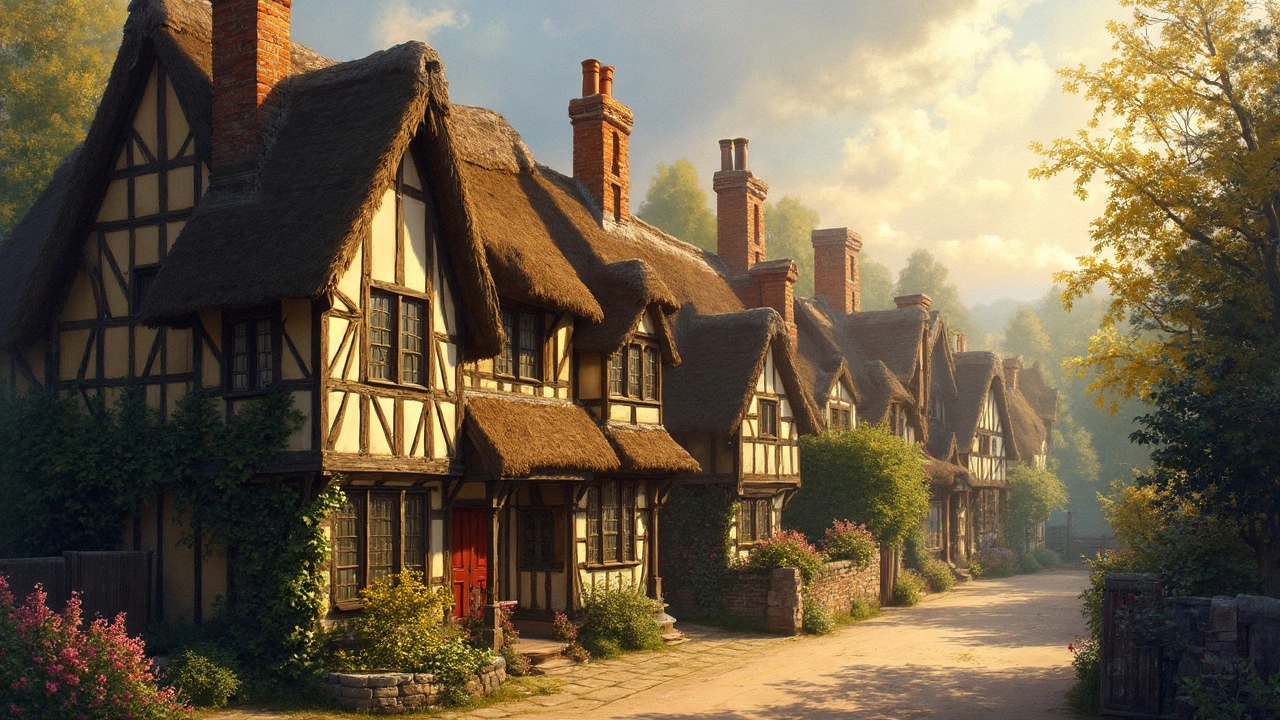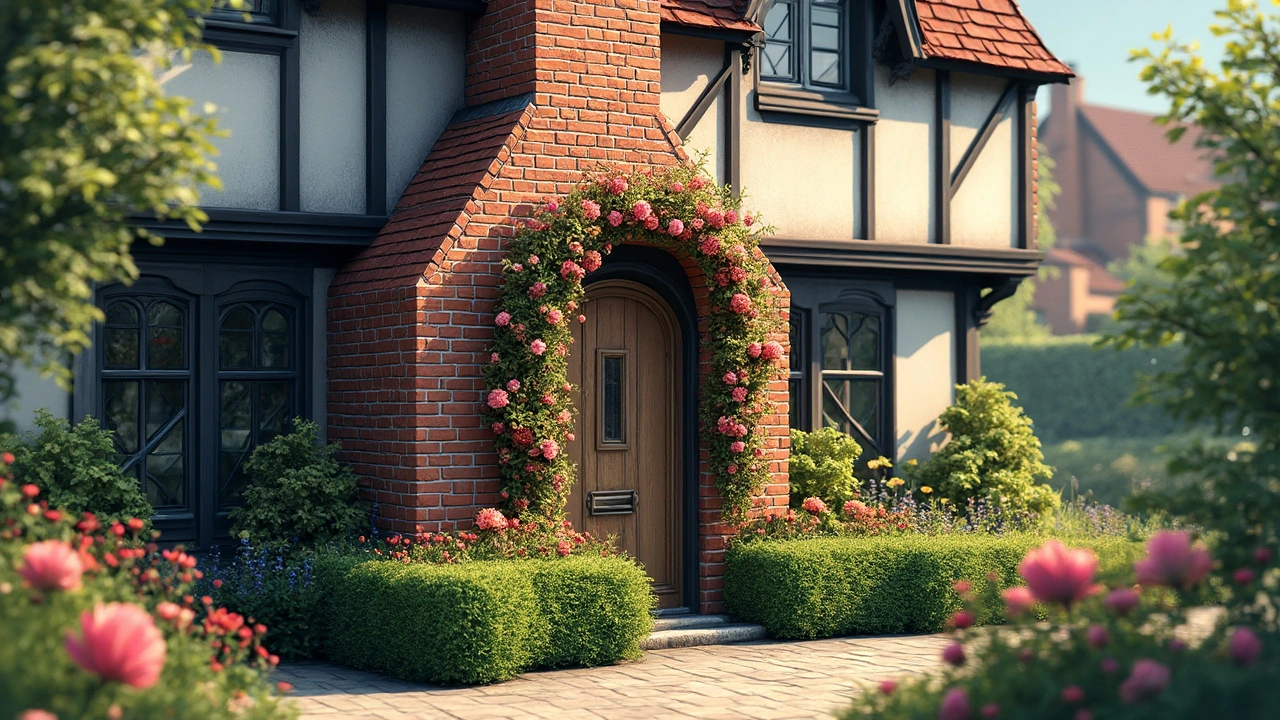Tudor Architecture: A Style That Stands the Test of Time
 Apr, 14 2025
Apr, 14 2025
Tudor architecture is like that one classic hit song you just can't get out of your head—it's timeless. Springing up in 16th-century England, this style has a certain charisma that keeps drawing folks in. Imagine stepping into a cozy home with a steeply pitched roof, majestic chimneys, and those charming timber-framed walls. That's a Tudor home for you.
But it's not all about looks. Tudor design brings a blend of old-world elegance and practical functionality. It's like if your daily coffee mug had gold trim—still your trusty mug, but with flair! Think about those high, narrow windows and how they flood your space with light while keeping it snug and secure at the same time. This isn't just about pretty faces; it's practical art.
- The Origin and Evolution of Tudor Architecture
- Key Features That Define Tudor Style
- Modern Adaptations of Tudor Design
- Why Tudor Architecture Remains Popular
The Origin and Evolution of Tudor Architecture
So, where did Tudor architecture get its start? Picture this: it's the late 15th to early 16th century in England. The country is moving away from medieval times, with people gunning for more comfort and less castle-like structures. That's when the Tudor style steps into the limelight, pushed by the Tudor monarchs, particularly Henry VII and Henry VIII.
Back then, resources were a massive factor in how homes were built. Timber was widely available and became the go-to material, giving us those classic half-timbered Tudor exteriors. But don't imagine a monotonous style. The Tudors loved a bit of flair. They added brick and stone to the mix, especially for places higher on the social ladder—the fancier your house, the more materials you mixed in.
This style didn't stay stagnant either. As builders got more creative, chimneys took on a new decorative life, no longer just functional lumps. And as glass production improved, they tossed in lead-light windows, giving homes that cozy yet airy feel.
Fast forward to the 19th and early 20th centuries, and boom—the Tudor Revival comes in. People were nostalgic or maybe just thought, "Hey, this looks cool," but Tudor architecture had a renaissance, especially in the UK and the US. These new builds kept the iconic timber features but often blended them with modern construction techniques, making a neat mix of old-school charm and new-world comfort.
Nowadays, the Tudor style has evolved once more, adapting modern needs while keeping its iconic features intact. This only proves that Tudor design isn't just clinging to its roots; it's striding confidently into the future, cape fluttering behind, maybe with a few pigeons for effect.
Key Features That Define Tudor Style
The magic of Tudor architecture lies in its unique charm and practical elements. This style is famous for its distinct look that combines rustic and royal vibes. One thing that immediately catches the eye is its steeply pitched gable roofs. These aren't just a design choice; they were initially crafted to handle England's sometimes rainy weather, ensuring a cozy and dry interior.
Another signature feature? Those stunning brick and stone chimneys. Back in the day, having elaborate chimneys was not just about heating— it was a bit of a status symbol too. Imagine showing off with your chimney! The extensive chimney stacks often feature decorative pots that add to their majestic look.
You'll also come across half-timbering, where wooden beams are exposed on the building's exterior. This isn't just for show; it helped strengthen the walls while adding extra character. It’s a design that combines good looks and strength.
Architectural historian John Smith notes, "Tudor homes were designed to impress and endure, reflecting the wealth and tastes of their owners while withstanding the changing seasons."
Windows in Tudor design are a thing of beauty too, with their narrow, rectangular shapes and diamond-patterned panes. These were practical for defense reasons back then but now offer a charming touch that lets in just the right amount of light.
- Timber-framed construction: Provides both strength and style with visible wooden beams.
- Ornate chimneys: Eye-catching and functional, they're a standout feature of Tudor homes.
- Steeply pitched roofs: Built to handle unpredictable weather, adding a dramatic exterior.
- Leadlight windows: Narrow and tall, they're designed with intricate wood or metal trim.
All these features together make Tudor homes not just about historical charm, but also showcase clever design choices from a bygone era that people still adore today.

Modern Adaptations of Tudor Design
Even though the roots of Tudor architecture are deeply planted in the past, it's not stuck there. Builders and homeowners today are revamping this style to fit contemporary lifestyles, and the outcomes are nothing short of amazing. Imagine pairing those traditional steep roofs with modern, energy-efficient materials. Yep, it's happening!
Open floor plans and smart home tech are making their way into Tudor design without losing the charm that makes it so beloved. High-speed internet alongside rustic wooden beams? It sounds like an odd couple, but it works. These updates ensure that the dwellings remain not only beautiful but also functional and future-ready.
Another cool aspect is the fusion of these homes with eco-friendly elements. Solar panels are cleverly integrated into those iconic pitched roofs, enabling homes to generate their own energy. Some even go the extra mile, using recycled materials to create the classic Tudor look without the environmental guilt. Here's where green living meets historical charm!
There’s also a fresh twist on the traditional color palette. While maintaining those warm, earthy tones that Tudors are known for, modern homes are spicing things up with bold accents—deep blues, vibrant greens, or even dark grays. It's like giving a vintage car a sleek new coat of paint.
Navigating the blending of new and old can lead to striking results. Contemporary adaptations make the Tudor style more accessible and inviting for today’s families. So if you're dreaming of a historic home without the historic problems, modern Tudor might just be your perfect answer. A stylish nod to the past that's prepared for tomorrow!
Why Tudor Architecture Remains Popular
Ever wonder why Tudor architecture still captivates homeowners and architects alike? Well, it’s not just nostalgia at play. The style’s allure lies in a few key elements that make it stand out even in today's modern world.
First off, there's the charm factor. Those timber-framed structures often combined with brickwork create a warm, storybook feel. It's like living in your own historical novel, and who can resist that? The steeply pitched roofs and decorative half-timbering aren't just charming; they also handle rain and snow like a pro, which is a big plus in many climates.
Then there's the versatility. Tudor design works beautifully in both countryside homes and urban settings, making it adaptable to different lifestyles. The interiors often boast open floor plans which allow for easy flow inside the home—perfect for hosting those lively family gatherings.
And let’s not forget the materials. Tudors are typically built with quality materials that withstand time and weather, meaning they require less maintenance than you might expect. It’s like having a wardrobe filled with designer pieces—they’re an investment but seriously worth it.
Finally, there’s this undeniable sense of elegance. While modern homes can sometimes feel stark, Tudor homes offer a rich texture and depth that's hard to replicate. Maybe it's the craftsmanship or the attention to detail, but stepping into a Tudor home often feels like stepping back into a time when every corner had a story.
So, whether you’re a fan of its enchanting looks, practical design, or enduring quality, the Tudor style continues to win hearts. It combines the best of history and function, proving that some styles are truly built to last.